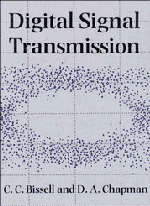Book contents
- Frontmatter
- Contents
- Preface
- 1 Introduction
- PART 1 MODELS
- PART 2 PROCESSES
- PART 3 DIGITAL TRANSMISSION OVER THE PUBLIC SWITCHED TELEPHONE NETWORK
- Appendix A Fourier series and transforms
- Appendix B Convolution
- Appendix C Modelling applications of spreadsheets
- Answers to numerical exercises
- References
- Index
PART 2 - PROCESSES
Published online by Cambridge University Press: 05 June 2012
- Frontmatter
- Contents
- Preface
- 1 Introduction
- PART 1 MODELS
- PART 2 PROCESSES
- PART 3 DIGITAL TRANSMISSION OVER THE PUBLIC SWITCHED TELEPHONE NETWORK
- Appendix A Fourier series and transforms
- Appendix B Convolution
- Appendix C Modelling applications of spreadsheets
- Answers to numerical exercises
- References
- Index
Summary
Suppose a digital signal at location A is to be transmitted to location B. In what way, if any, should the signal be processed before transmission over a particular digital link? At the very least the transmitted signal power needs to be sufficient for there to be an adequate signal to noise ratio at B, so amplification may be required prior to transmission. In practice there may be many other ways in which the signal is processed before transmission. Once at B, the conveyed signal needs again to be processed to recover the original signal and, possibly, to check that it has not been degraded in transmission.
In order to classify the various processes used for such purposes, we have found it convenient to use a layered model, akin to the OSI 7-layer model mentioned in Chapter 1. The OSI model itself is not, however, appropriate, since most of the processes discussed here would fall within the single ‘physical’ layer of the OSI model. Our model uses three layers and is shown in Fig. 2. It is assumed that the signal to be transmitted (which may originate at an inherently digital source such as a computer, or may be PCM coded speech, as discussed in Chapter 7) exists as a binary data sequence with an associated timing waveform. The three levels of processing for transmission are then as follows:
Information
- Type
- Chapter
- Information
- Digital Signal Transmission , pp. 95 - 99Publisher: Cambridge University PressPrint publication year: 1992
